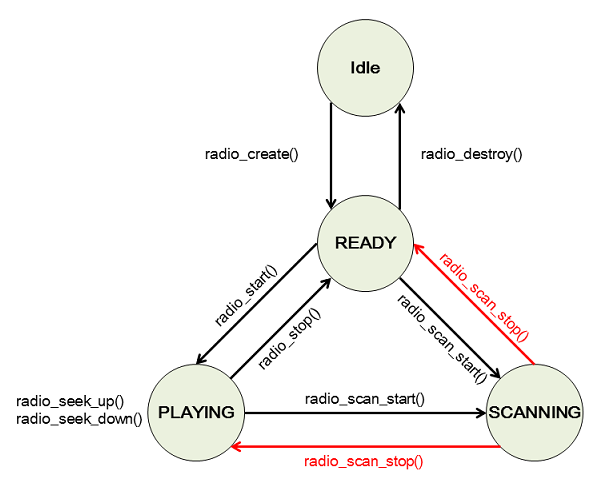Radio
Tizen provides functions for controlling radio hardware on your system.
The main features of the Radio API include:
-
Switching the radio on and off
You can create a handle for a radio instance using the
radio_create()function. A successful creation of the handle requires a radio tuner. You can switch the radio on and off using theradio_start()andradio_stop()functions. -
Scanning for radio frequencies
You can scan for all available frequencies.
-
Tuning the radio
You can select and start playing a radio frequency using the
radio_set_frequency()function. -
Searching for an adjacent channel
You can seek an adjacent channel with the
radio_seek_up()andradio_seek_down()functions.
The Radio API allows only one instance at the time. Radio playback can be interrupted by another radio application.
The following figure illustrates the general radio state changes.
Figure: Radio state changes

Prerequisites
To enable your application to use the radio functionality:
-
To use the functions and data types of the Radio API (in mobile and wearable applications), include the
<radio.h>header file in your application:#include <radio.h> -
Define a handle for the radio using the
radio_create()function:#define MAX_FREQUENCIES 10 struct radioInfo { radio_h radio; int frequencies[MAX_FREQUENCIES]; int num_freq; int selected_channel; }; typedef struct radioInfo mRadioInfo; mRadioInfo mRadio; ret = radio_create(&mRadio.radio); if (ret != RADIO_ERROR_NONE) return false; -
To receive notifications when the radio playback is interrupted, register a callback function using the
radio_set_interrupted_cb()function:ret = radio_set_interrupted_cb(mRadio.radio, on_radio_interrupted, &mRadio); if (ret != RADIO_ERROR_NONE) { /* Delete the radio handle before closing the application */ return false; }Radio playback is interrupted, for example, when the application moves to the background.
-
Implement the interruption callback:
static void on_radio_interrupted(radio_interrupted_code_e code, void* userdata) { /* Retrieve the radio handle from userdata */ mRadioInfo* mRadio = (mRadioInfo *)userdata; switch (code) { case RADIO_INTERRUPTED_BY_RESOURCE_CONFLICT: /* Radio listening is interrupted by resource */ /* Release the application resources or save the current state here */ break; default: break; } }
Scanning for Radio Frequencies
To scan for all available radio frequencies:
-
To receive a notification when the scan is completed, register a callback function using the
radio_set_scan_completed_cb()function:ret = radio_set_scan_completed_cb(mRadio.radio, on_scan_finished, &mRadio); if (ret != RADIO_ERROR_NONE) return false; -
Implement the scan complete callback:
void on_scan_finished(void* userdata) { /* Frequency scanning is completed */ /* Tune in to one of the scanned frequencies and start listening */ } -
Start scanning:
radio_scan_start(mRadio.radio, on_scan_updated, &mRadio);The scanning time depends on the environment (the strength of the radio signal).
Each time the scan finds a new frequency, it calls the
on_scan_updated()callback function, which returns the kHz value of the frequency. To cancel the scan before it completes, use theradio_scan_stop()function. -
Implement the scan update callback that returns the available frequencies:
void on_scan_updated(int frequency, void* userdata) { mRadioInfo* mRadio = (mRadioInfo *)userdata; /* Store the radio channels in the array */ /* Frequency values represent the kHz of the channel */ mRadio->frequencies[mRadio->num_freq++] = frequency; }Note
Do not call radio functions (such asradio_set_frequency()orradio_start()) in the callback function.
Tuning the Radio
To select and start playing a frequency:
-
Set the frequency you want to play using the
radio_set_frequency()function:ret = radio_set_frequency(mRadio.radio, mRadio.frequencies[mRadio.selected_channel]); if (ret != RADIO_ERROR_NONE) return false; -
Start playing the frequency using the
radio_start()function:ret = radio_start(mRadio.radio); if (ret != RADIO_ERROR_NONE) return false;If the radio emits no sound, check the signal strength with the
radio_get_signal_strength()function, which returns the current signal strength as a dBuV value.
Searching for an Adjacent Channel
To search for and tune in to an adjacent channel:
-
Search for an active adjacent frequency using the
radio_seek_up()andradio_seek_down()functions.This is similar to the scanning operation, but only the nearest active frequency is searched for. Once the maximum frequency is reached in either direction, the search ends, and the radio is set to that frequency.
To seek down, use the
radio_seek_down()function:ret = radio_seek_down(mRadio.radio, on_seek_completed, &mRadio); if (ret != RADIO_ERROR_NONE) return false;To seek up, use the
radio_seek_up()function in the same way. -
Implement the search complete callback that returns the adjacent frequency:
void on_seek_completed(int frequency, void* userdata) { mRadioInfo *mRadio = (mRadioInfo *)userdata; int new_frequency = 0; /* Search is complete, and the radio is tuned in to the new frequency */ /* Application sets the new frequency and updates the user interface */ radio_get_frequency(mRadio->radio, &new_frequency); }
Related Information
- Dependencies
- Tizen 2.4 and Higher for Mobile
- Tizen 2.3.1 and Higher for Wearable